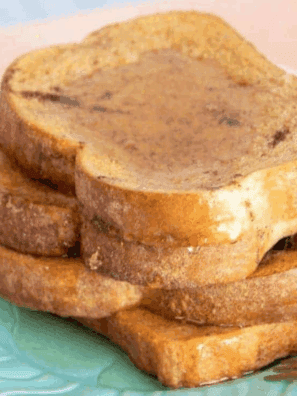How Long Does French Toast Last in the Fridge –Ah, French toast. We all know the delicious, syrupy goodness it brings. But do you ever think about how long it would last in the fridge? Keeping your French toast fresh and tasty for a longer period is essential for any breakfast aficionado.

Below, we will explore how long you can keep your homemade or store-bought French toast before it goes bad. So grab that plate of piping hot bread slices soaked in an egg mixture, and let’s dive into the world of breakfast heaven!
Storing Leftover French Toast Batter
Navigating the lifespan of our favorite dishes in the refrigerator can be tricky. With its delicate balance of egg-soaked bread and delightful flavors, French toast is no exception. Whether you’ve made a large batch for Sunday brunch or prepped ahead for a hassle-free weekday breakfast, knowing how long your French toast remains fresh and safe to eat is essential. Storing it correctly can extend its shelf life and preserve its delicious taste and texture. Let’s delve into how long French toast can be safely stored in the fridge and how to maximize its freshness.
This is a great way to meal prep and makes for an excellent recipe for the next day, for a delicious breakfast.
Why Make French Toast Ahead Of Time?
Making French toast ahead of time offers a myriad of benefits, especially for those with bustling mornings or those planning for gatherings:
- Streamlined Mornings: Preparing breakfast can be time-consuming, especially on busy weekdays. By making French toast in advance, you can have a delicious meal ready to go with minimal effort.
- Consistent Results: Cooking in a relaxed setting, perhaps the evening before, allows for more consistent and thoughtful preparation. This can lead to better results in terms of flavor and texture.
- Serve Many at Once: If you’re hosting a brunch or have a large family, making French toast ahead ensures everyone gets a warm plate at the same time. No more waiting for the next batch to come off the griddle!
- Flavor Development: As with many dishes, French toast can benefit from a resting period. When allowed to sit, the flavors meld and deepen, producing a richer taste when reheated.
- Reduced Stress: Cooking for guests can be stressful. Prepping dishes like French toast ahead of time means you can focus on enjoying the company rather than being tied to the kitchen.
- Versatility: Once you have prepared a batch of French toast, it can be dressed up in various ways on different days. One day, it could be served with fresh berries and honey; the next, it might be paired with a savory side. This keeps the meal exciting, even from a pre-made batch.
- Minimize Wastage: If you find yourself with leftover bread going stale, making a large batch of French toast is an excellent way to utilize it, preventing waste and creating delicious meals for future consumption.
In essence, making French toast ahead of time is a convenience and a strategy for those aiming to optimize their meals, whether for taste, time, or hosting prowess.

The Best Way To Store French Toast
Storage conditions of your French toast are key to maintaining its flavor, texture, and overall quality. Follow these steps to ensure that your homemade French toast stays as delightful as when you first made it:
Cool Completely: Ensure the French toast has cooled to room temperature before storing. Place on a wire rack or cookie sheet. This prevents condensation from forming in the storage container, which can make soggy French toast.
Choose the Right Container: Use airtight containers or resealable plastic bags. These protect the French toast from absorbing other odors in the fridge and maintain its freshness.
Layer with Parchment Paper: Place a sheet of parchment paper or sheet of wax paper between each slice if you’re stacking French toast slices. This prevents them from sticking together and makes it easier to take out individual slices when needed.
Label and Date: If you frequently meal prep or store leftovers, labeling the plastic bag or container with the date you made the French toast can help you track its freshness.
Refrigerate: Properly stored French toast can last 3-4 days in the refrigerator. Remember, the sooner you eat it, the better the taste and texture.
For Longer Storage – Freeze: If you want to store French toast for an extended period, consider freezing it. Lay the slices in a single layer on a baking sheet and freeze until solid. Then, transfer the pieces of French toast to airtight containers or resealable heavy-duty freezer bags, separating layers with parchment paper—label, date, and store. Frozen French toast can last for 1-2 months. You can reheat directly from the freezer when you’re ready to eat.
Reheating: When you’re ready to eat, the best way to reheat refrigerated or frozen French toast is by using an oven, a toaster oven, or an air fryer. This method will restore its crispy edges while keeping the center soft. Microwaving is quick but might result in a slightly soggier texture.
Avoid Repeated Temperature Changes: Taking French toast in and out of the freezer or fridge can degrade its quality. Decide how many slices you want to consume and reheat only that amount.
Following these best storage practices, you can enjoy delicious French toast without compromising its delightful taste and texture whenever the craving strikes.

What Is The Shelf Life of French Toast
The shelf life of French toast depends on how it’s stored:
At Room Temperature: It’s not recommended to leave French toast at room temperature for more than 2 hours. Beyond this, there’s an increased risk of bacterial growth and food poisoning, especially since the toast contains eggs.
In the Refrigerator: When properly stored in an air-tight container or tightly wrapped in plastic wrap, cooked French toast lasts 3-4 days. Ensure that it’s cooled to room temperature before refrigerating to prevent condensation from forming inside the container, which can make the toast soggy.
In the Freezer: For longer storage, French toast freezes amazingly. When stored properly in an airtight container or freezer bag (and ideally separated by parchment paper to prevent sticking), it can last for 1-2 months.
It’s important to note that while the French toast may remain safe to eat after these timeframes, its quality in terms of taste and texture might degrade. Always check for signs of spoilage like an off-smell or mold, and if in doubt, it’s best to discard it. Also, always remember to label and date your stored items to keep track of their freshness.
How To Serve French Toast
Serving French toast is a delightful experience that offers a plethora of creative avenues. From classic toppings to innovative accompaniments, here’s a guide to my favorite toppings to elevate your French toast serving game:
- Classic Toppings:
- Butter: A pat of melted butter on warm French toast adds a rich, creamy texture.
- Maple Syrup: The quintessential French toast topping, its sweetness perfectly complements the savory note of the toast, with a drizzle of brown sugar for added sweetness.
- Powdered Sugar: A light dusting can make your plate look gourmet and add a gentle sweetness.
- Fruit Delights:
- Fresh Berries: Fresh fruit, such as Blueberries, raspberries, strawberries, and blackberries, add color, texture, and natural sweetness.
- Banana Slices: These can be layered on or served on the side.
- Cooked Apples or Pears: Sautéed in butter and cinnamon, these make for a warm, comforting topping.
- Citrus Zest: A bit of grated orange or lemon zest can elevate the flavor profile.
- Nuts and Seeds:
- Chopped Nuts: Think pecans, walnuts, or almonds for a crunchy contrast.
- Chia or Flaxseeds: For a healthy twist and a slight crunch.
- Dairy and Alternatives:
- Whipped Cream or Ice Cream: A dollop can make your French toast feel like a dessert.
- Yogurt: Adds a tangy contrast, especially Greek yogurt.
- Dairy-Free Alternatives: Coconut whipped cream or almond yogurt for those avoiding dairy.
- Savory Takes:
- Bacon: Who can resist the classic sweet French toast and salty bacon combo?
- Eggs: Serve with scrambled eggs or a sunny-side-up for a hearty breakfast.
- Cheese: Cream cheese spreads, ricotta, or mascarpone can provide a rich contrast.
- Syrups and Sauces:
- Berry Compote: Cook down berries with sugar for a homemade fruity syrup.
- Chocolate Syrup or Nutella: For a dessert-like twist, a drizzle of maple syrup.
- Caramel or Butterscotch Sauce: Decadent and rich, perfect for a treat.
- Spices and Flavors:
- Cinnamon and Nutmeg: A sprinkle for warmth and spice.
- Vanilla or Almond Extract: A few drops can be drizzled on top or incorporated into syrups.
- Accompaniments:
- Coffee or Tea: A warm beverage pairs wonderfully, balancing the sweetness of the toast.
- Juices: Orange, apple, or a tropical mix can be refreshing.
Remember, serving French toast is as much about presentation as it is about taste. Use colorful fruits, a sprinkle of powdered sugar, or even some edible flowers to make your plate Instagram-worthy. Whether you lean classic, adventurous, or somewhere in between, a French toast serving method is perfect for every palate!

How long can French toast be left at room temperature?
It’s not recommended to leave French toast at room temperature for more than 2 hours because of the risk of bacterial growth, especially since it contains egg.
How Long Does French Toast Last in the Fridge
Yes, French toast can be refrigerated. Once cooled to room temperature, store it in an airtight container, lasting up to 3-4 days.
How do I freeze French toast?
To freeze French toast, first, let it cool completely. Place individual slices on a baking sheet in a single layer and freeze until solid. Then transfer the slices to a freezer bag or airtight container, separating layers with parchment paper. Label and date the container.
How long will French toast last in the freezer?
When stored properly in an airtight container or freezer bag, French toast can last in the freezer for 1-2 months.
How do I reheat stored French toast?
For best results, reheat refrigerated or frozen French toast in an oven, toaster oven, or air fryer until it’s hot and crispy. While microwaving is quick, it might result in a soggier texture.
Why is my stored French toast soggy?
Sogginess can occur due to condensation if the French toast is still warm or stored in a non-airtight container. It’s crucial to let the toast cool to room temperature before storing it and to use airtight containers.
Can I make French toast in advance for a week’s breakfast?
Yes, you can prepare French toast in advance and store it in the refrigerator or freezer, then reheat it as needed. It’s an excellent option for busy mornings!
Is there a difference in storage methods for savory versus sweet French toast?
The basic storage principles remain the same regardless of the French toast type. However, if the savory French toast contains perishable toppings (like cheese or meat), it may have a shorter fridge life.
How do I know if my stored French toast has gone bad?
Signs of spoilage include an off-smell, mold, or a change in texture. If in doubt, it’s best to discard it.
Can I refreeze previously frozen French toast?
It’s generally not recommended to refreeze foods that have already been frozen and thawed, including French toast, due to potential texture and flavor degradation, as well as safety concerns.






